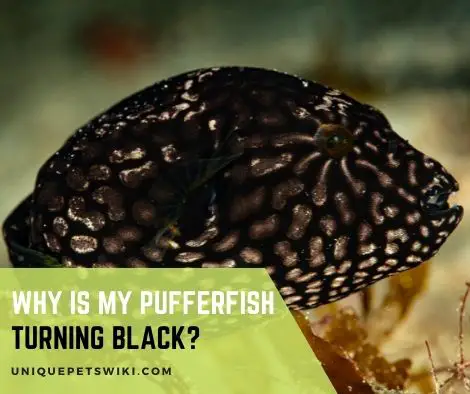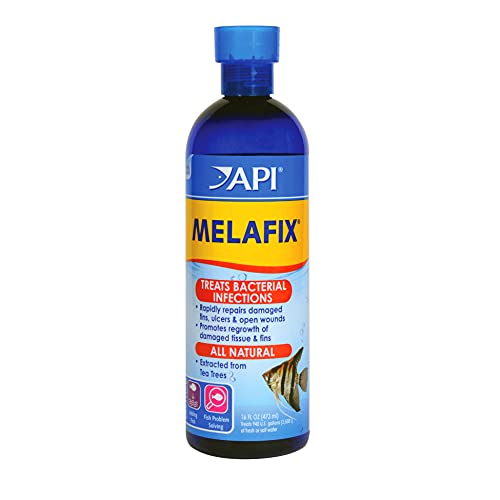Puffer fish are available in various colors like yellow, green, white, grey, etc. Naturally, if you’re wondering ‘why is my puffer fish turning black?’ then it can be a worrisome sight indeed.
The once bright and attractive puffer fish turning a hideous black is not something any pufferfish owner wants to see.
However, before you start to panic, it is important to investigate the matter. There are different causes as to why a puffer fish may start taking on a blackish appearance and thankfully, not all of them are serious.
This guide explains everything related to why a puffer fish may be turning black, whether it is something you should worry about, and most importantly, what you can do about it.
Contents
Do Puffer Fish Change Color?
Yes, there are several reasons why a puffer fish may change its colors.
Typically, puffer fish come in colors like dark olive green, yellow, grey, black, or white. Their bellies are almost always white in color.
However, these colors could change over the course of the puffer’s lifetime. Mostly, these color changes depend upon the fish’s age, mood, stress levels, and environment.
A healthy and jolly puffer fish will display vibrant colors. Conversely, a stressed or unhappy fish will display dull colors. Sometimes, the color changes depend upon the time of the day.
For example, some species of puffers like Dwark Puffers tend to look dull in the morning but become brighter as the day progresses.
A hungry puffer fish will also appear pale and weak. Stress and anger can also cause puffer fish to appear darker. Likewise, puffer fish may change their colors to blend with their surroundings and camouflage themselves from their predators.
Why Is My Puffer Fish Turning Black?
A puffer fish turning black can have several reasons. Mainly, the color change occurs when the fish wants to camouflage or blend in with the surroundings.
Hunger, stress, and anger are some other causes. Poor water parameters are also an important cause.
It is important that you monitor your fish if it is showing a distinct color change. If its color returns to normal, then it might be a one-off thing and there isn’t a cause for worry.
However, if your fish continues getting darker in appearance or there are other worrisome symptoms such as swimming in frenzy or tail tucked up near its head, then you may want to consult your vet.
Let us study each of the probable causes of puffer fish turning black:
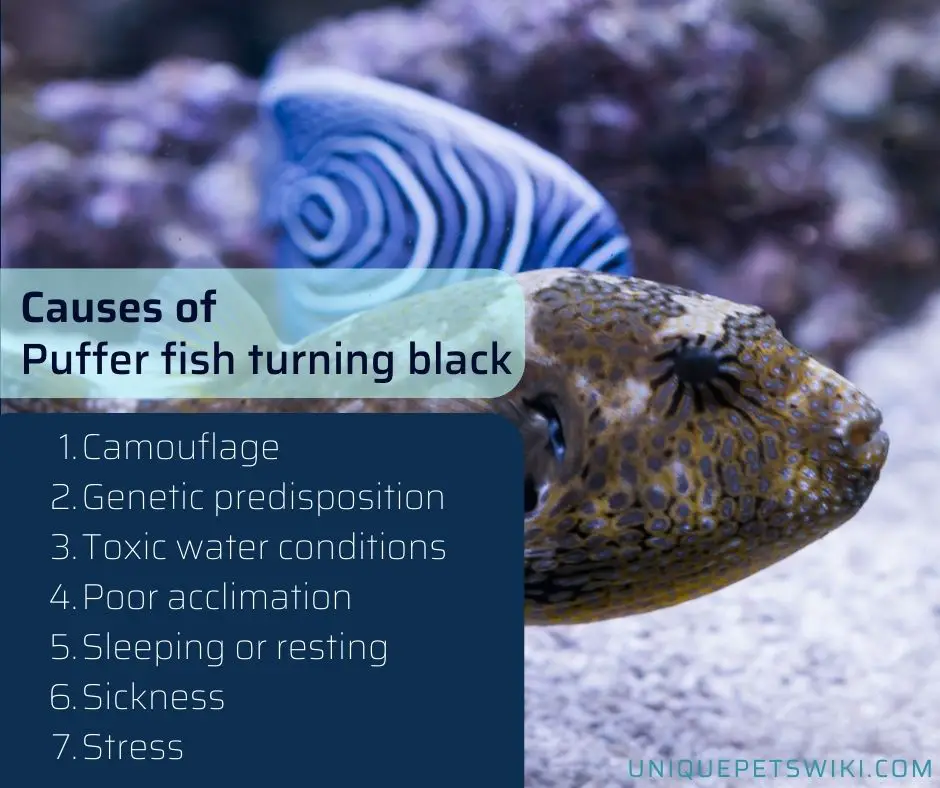
Camouflage
Research shows that like all fish, certain puffer species can hide in the ocean from their predators by changing their colors. They do so by manipulating the way light reflects off their bodies.
In general, all pufferfish have darker color on their upper side and a lighter shade on their bellies. Their dark-colored bodies are harder for predators to spot when looking from above.
Moreover, by becoming darker, they blend in with the substrate or sand and remain invisible to their predators.
If your pufferfish is not showing any other signs of stress and reverts back to its original color, then you can attribute the color change to camouflage.
Try using a lighter substrate to see if your puffer fish reverts back to its lighter shade.
Genetic predisposition
Some pufferfish can change colors because they have the genetic predisposition to do so. Of course, in most cases, such color-changing puffer fish turn either lighter or darker and not necessarily black.
Take a look at this Potato Pufferfish (TETRAODON MIURUS). It is known as the master of disguise since it cleverly digs and changes its color to blend in with the background.
Sometimes, such genetic color changes can also occur when the fish transitions from juvenile into adulthood.
As long as your puffer fish is eating normally and swimming happily, you need not worry or do anything.
Toxic Water Conditions
When any fish starts turning black rapidly and dies suddenly, then the most common reason is ammonia burns caused by toxic water.
Too much ammonia in the water can literally cause scale burns on the fish resulting in blackish marks or black appearance all over its body.
Ammonia levels rise due to dirty water. You might have plants in the tank that may be rotting resulting in an increase in ammonia levels.
Overfeeding your fish can also be a cause of higher ammonia. Pufferfish do not devour everything you feed it. Your fish does not need too much food and leftover food is sure to convert into ammonia.
The rotting food bits and decaying plant leaves react with chemicals in the air to create ammonia gas. Ideally, the ammonia level should be 0.
Anything more than that could cause slow burns on your puffer’s body and slowly turn it black all over.
Please check the water parameters using a water testing kit. If the ammonia is high, please make water changes. Also, use a filter.
Poor Acclimation
If you have recently brought a new puffer fish or placed it in a newly cycled tank, then one of the signs that it has not acclimatized to the new tank is turning blackish all over.
Many factors can result in poor acclimation:
- Your puffer needs to adjust to the new water temperature. Fish are cold-blooded so they cannot regulate their temperature easily.
- pH – For freshwater puffers, pH needs to be 6.8 – 7.6, and for saltwater puffers, it needs to be 8.1 to 8.4. High levels of pH can strip the protective slime off the puffer’s body resulting in a darkish or dull appearance. Likewise, lower pH levels can cause the water to be acidic resulting in burns on your fish with a black appearance.
- Light – too much light can stress out your puffer. Stress can result in a blackish appearance or loss of color.
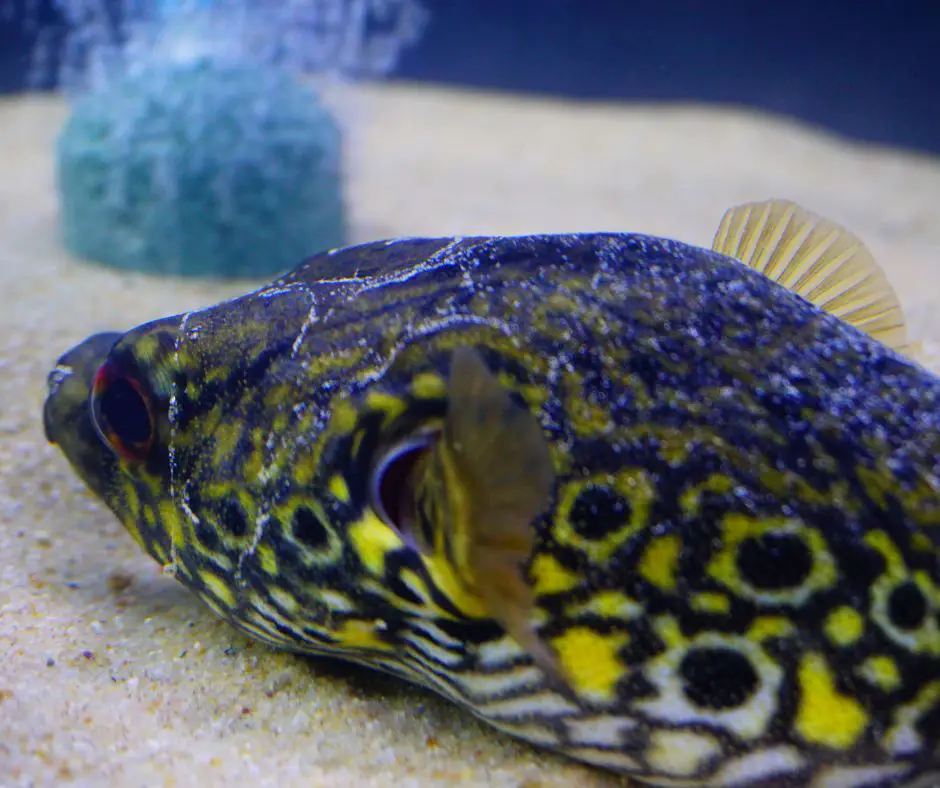
Sleeping or resting
According to experts, many fish turn darker in color while sleeping or resting. This is again a strategy they use to remain invisible to predators.
Other signs of resting or sleeping are inactivity, hovering in the tank (generally lower in the water an inch or two from the tank’s bottom), and head slightly turned downwards.
Sickness
Disease and ill health are some other reasons why a puffer may turn black. A disease known as black spot disease or black ich is one of the common reasons why a puffer fish may start turning black.
You might see black raised nodules all over the fish’s body, fin, and tail. The disease is caused by parasitic larvae.
If you suspect your puffer fish is infected with ich, please talk to a vet right away. Some products like Cupramine could be useful in treating ich in freshwater and marine puffers.
Seachem Cupramine Copper 100ml
- Buffered active copper
- Effective against external parasites
- For marine and freshwater use
Last update on 2022-12-29 / Affiliate links / Images from Amazon Product Advertising API
Stress
Stress can also result in lackluster color and dull or black appearance in pufferfish. Worse, it can result in fin rot or dropsy which can be fatal.
Causes of stress in puffer fish include:
- Poor tank conditions
- Trouble with other fish
- Presence of chemicals or medicines in the water
- Irregular feeding hours
- Poor diet
Symptoms of stress in puffer fish are:
- Dull or black appearance
- Erratic or strange swimming
- Lack of appetite
- Disease and ill-health
If you suspect your puffer fish is stressed, then please try to determine the root cause. Test the water and note down other symptoms. If needed, discuss this with your vet.
Do You Need to Worry If Puffer Fish Turning Black?
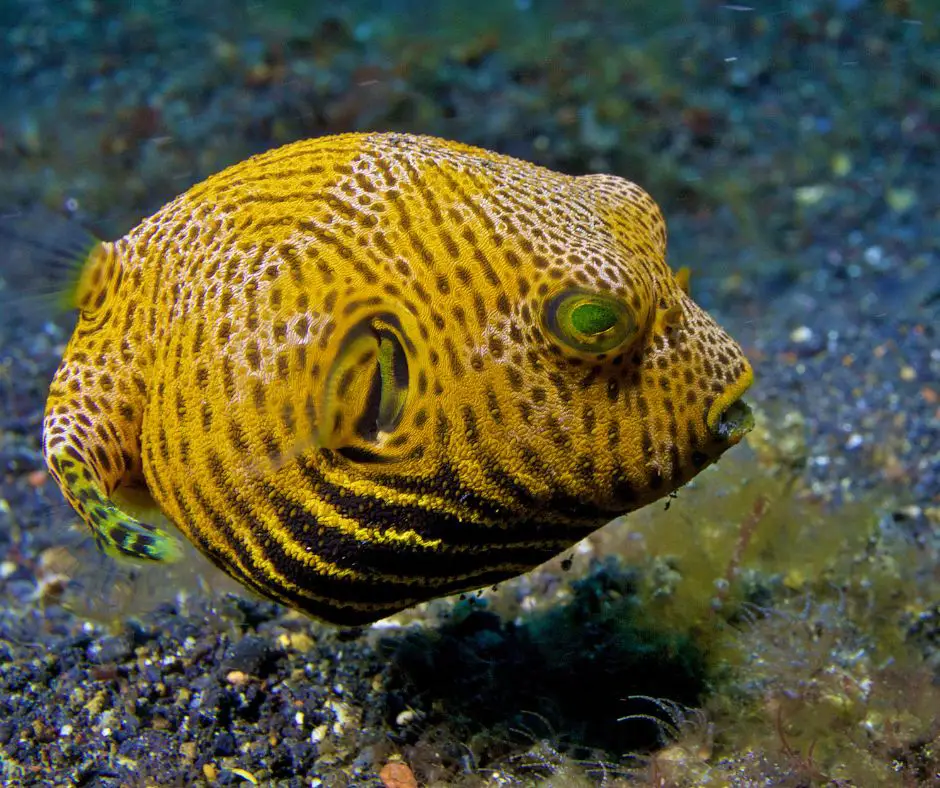
In most cases, pufferfish self-regulate and get back on track with their health. Mostly, your puffer is hungry or resting. The color will restore to normal after these needs are met.
However, if the black color does not disappear after 24 to 36 hours, then you may want to take certain steps.
What Should You Do If Your Puffer Fish Turns Black?
- Observe your fish for other symptoms. Is it’s swimming erratic? Is it simply resting? Have you fed it on time?
- Test the water. Make sure the ammonia, nitrates, and nitrites are optimum. Also, test the pH, salinity, and temperature.
- Look for signs of sickness or ich.
- Make 50% water changes. If needed, use a water pump or filter.
- Consider treating your tank with Melafix or Cupramine but only after consulting a vet.
API MELAFIX Freshwater Fish Bacterial Infection Remedy 16-Ounce Bottle
- Contains one (1) API MELAFIX Freshwater Fish Bacterial Infection Remedy 16-Ounce Bottle
- Heals bacterial infections and repairs damaged fins, ulcers and open wounds
- Contains natural, botanical tea tree extract to quickly and rapidly help fish
- Helps treat newly-introduced fish to reduce risk of disease outbreak in freshwater aquariums
- Use daily for a week when treating infections and for 3 days as a preventive when adding new fish
Last update on 2022-12-29 / Affiliate links / Images from Amazon Product Advertising API
How to Prevent Your Puffer Fish from Turning Black Again?
If your pet is simply resting or sleeping and that is causing the color change, then you need not do anything.
However, if your puffer is turning black due to stress, then you can take the following steps to ensure it remains healthy and bright in color:
- Maintain a clean and ammonia-free tank. Ensure all water parameters (temperature, salinity, and pH) are just what your species of puffer fish need. Test the water frequently and make water changes every week.
- Use a lighter substrate or add some low lights around the aquarium. (Note that some marine puffer fish tend to get stressed due to bright light. However, this depends on the pufferfish’s species. So, please research your particular species carefully and select lighting accordingly).
- Use a large tank and ensure there is no bullying in the tank from other fish. If needed, separate your puffer fish. Make sure it has acclimatized to the new tank.
API FRESHWATER MASTER TEST KIT 800-Test
- Contains one (1) API FRESHWATER MASTER TEST KIT 800-Test Freshwater Aquarium Water Master Test Kit, including 7 bottles of testing solutions, 1 color card and 4 glass tubes with cap
- Helps monitor water quality and prevent invisible water problems that can be harmful to fish and cause fish loss
- Accurately monitors 5 most vital water parameters levels in freshwater aquariums: pH, high range pH, ammonia, nitrite, nitrate
- Designed for use in freshwater aquariums only
- Use for weekly monitoring and when water or fish problems appear
Last update on 2022-12-30 / Affiliate links / Images from Amazon Product Advertising API
Conclusion – Why Is My Puffer Fish Turning Black?
Pufferfish can turn black due to several reasons. Sometimes, it may be innocuous reasons like resting or sleeping. However, poor water parameters, sickness, and stress can also result in the darkening of pufferfish skin.
We hope this guide helps you find the exact cause and resolution for this condition.
